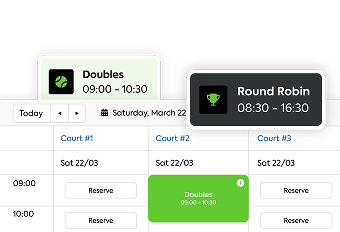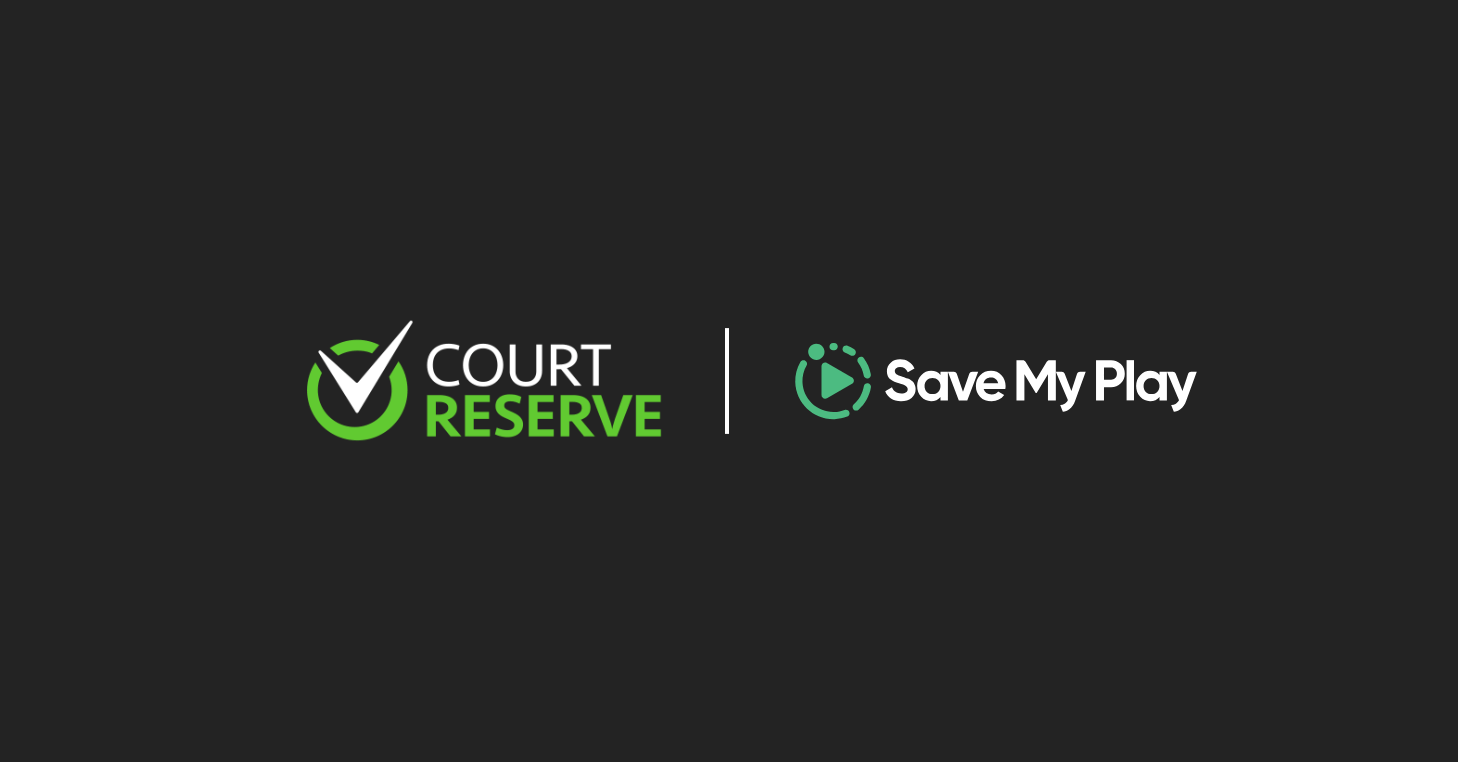We’ve all heard the saying, “If you love what you do, you’ll never work a day in your life.” But the truth is, even when you love what you do, it can still be stressful and exhausting – especially when you’re managing all the moving parts of a tennis or pickleball club.
Between organizing programming, managing court bookings, handling payments, marketing your offerings, and keeping a steady flow of players, it can feel like you’re constantly putting out fires instead of optimizing or growing your business.
If that sounds familiar, you’re not alone. Many owners and managers pour their hearts into their tennis and pickleball clubs, only to find themselves stretched too thin, juggling too many responsibilities, and running on empty.
However, it doesn’t have to be this way. With the right strategies, you can run a successful pickleball club without burning yourself out in the process. In this guide, we’ll help you identify the signs of burnout, what contributes to it, and what you can do about it.
Jump to the section that matters most to you:
How do you know if you’re burnt out? 4 warning signs
Why burnout is common among owners & managers
Common operational inefficiencies in tennis & pickleball clubs
How to refine tennis & pickleball operations and reduce stress
1. Implement club management software
2. Delegate and empower staff
3. Automate repetitive tasks
4. Streamline member communication
5. Embrace a growth framework
6. Establish a clear vision to avoid decision overload
7. Prioritize wellbeing and self-care
Burnout: The silent threat to tennis & pickleball club management
At its best, running a tennis or pickleball club is a labor of love and incredibly rewarding. But when you’re handling everything yourself – or dealing with outdated, inefficient systems – that passion can quickly lead to exhaustion and burnout.
Instead of focusing on meaningful ways to grow your club, you’re stuck in the daily grind – answering emails, fixing scheduling conflicts, handling member concerns, and constantly scrambling to keep up.
Over time, the long hours, constant problem-solving, and never-ending to-do list starts to take a toll. And that’s when burnout sets in.
What is burnout?
In a business context, burnout is more than just feeling tired – it’s a state of emotional, physical, and mental exhaustion caused by prolonged stress. It happens when the demands of running your club consistently outweigh the resources, support, or time you have to manage them.
If left unchecked, burnout can turn something you once loved into something that feels impossible to sustain.
How do you know if you’re burnt out? 4 warning signs
Burnout doesn’t happen overnight – it builds gradually, often setting in so subtly that you don’t realize it until you’re already deep in it. If you’re wondering whether burnout is setting in, here are some key warning signs to watch for:
1. Reduced performance & slower decision-making – Overwhelmed with simple tasks, slower response times, difficulty concentrating, more mistakes or oversights, and a decline in productivity and creative problem-solving.
2. Increased irritability – Frustrated by everyday challenges, quick to snap, loss of patience, and struggling to handle unexpected issues.
3. Physical symptoms – Chronic fatigue, headaches, muscle tension, sleep disruptions, weakened immune system, etc.
4. Emotional detachment & loss of passion – Feeling disengaged, emotionally drained, indifferent to success, and disconnected from staff or members.
Why it’s common among tennis & pickleball club owners & managers
As a club owner or manager, your job isn’t just one role – it’s all of them. From program scheduler and marketer to bookkeeper and customer service rep – you’re ingrained in every aspect of the business.
With so many responsibilities pulling you in different directions, it’s no surprise that burnout is common in club management. The demands never stop. Members expect quick responses, programming needs constant attention, and financial pressures loom over every decision. So, it’s easy to feel like you’re in a constant uphill battle.
Michael “Mookie” McDevitt, Vice President of Strategic Partnerships at Ace Pickleball Club, explains, “Anyone who is passionate about the health and performance of the club is going to have a hard time shutting down, and that includes everyone from owners to hourly employees. There are a million things to tinker with in the club, and it’s easy to become obsessed with the details.”

“Anyone who is passionate about the health and performance of the club is going to have a hard time shutting down, and that includes everyone from owners to hourly employees.”
Michael McDevitt, VP of Strategic Partnerships at Ace Pickleball Club
Here are some reasons why burnout is so common in club management:
- Too many roles, not enough time
Club owners and managers juggle court reservations, payments, staffing, marketing, financials, event planning, player communication, and so on – often without the right systems in place or enough support.
- High community expectations
Members expect quick responses, easy bookings, and well-run programming. This creates an “always-on” pressure, where club owners feel like they can’t step away without things falling apart. Common challenges include managing member communication, tracking attendance, and collecting payments.
- Competition from other facilities
Clubs face increasing competition from other facilities. This creates challenges around player engagement, fluctuating revenue, and service differentiation – requiring constant effort in marketing, programming, and player retention.
- Trying to grow or optimize business while staying afloat
For many club owners, just keeping the club running smoothly feels like a full-time battle. But on top of that, there’s the pressure to grow and optimize your business. Expanding programming, increasing memberships, and finding new revenue streams require time, strategy, and investment – resources that are already stretched thin.
Instead of focusing on long-term success, many club owners are stuck in survival mode – constantly putting out fires, handling urgent tasks, and struggling to carve out time for business development. This endless cycle of ‘working hard but never feeling like you’re moving forward’ is one of the biggest contributors to burnout.
Identifying operational inefficiencies that contribute to high-stress
The first step to reducing burnout isn’t working harder – it’s identifying where your club’s operations are working against you.
Outdated, inefficient processes create unnecessary stress, waste precious time, hold you back, and make daily operations harder than they need to be.
Instead of focusing on growth and sustainability, you’re stuck in survival mode – managing scheduling conflicts, chasing payments, fielding member requests, and scrambling to keep things organized. Every day feels like a battle, leaving little time or energy to step back and run your club the way you envisioned.
By identifying the biggest bottlenecks in your operations, you can take back control and free up your time to focus on big-picture goals. After all, the goal isn’t just to keep up – it’s to build a club that runs smoothly and efficiently without draining you in the process.
Common operational inefficiencies in tennis & pickleball clubs
Tennis and pickleball club operational inefficiencies often go unnoticed because they’ve become part of the daily routine. Taking a step back to evaluate where friction exists in your daily operations reveals opportunities to streamline processes, save time, and reduce stress.
To help you assess potential improvements in your club, let’s first review some of the most common inefficiencies that hold clubs back:
- Managing memberships and reservations by hand
If you’re manually managing memberships and reservations (via pen & paper or spreadsheets), mistakes are inevitable. Double bookings, scheduling conflicts, and last-minute changes create ongoing frustration for both staff and members. And without an automated system, balancing peak and off-peak hours and tracking membership renewals becomes a never-ending challenge.
- Using fragmented tools
Jumping between disconnected platforms for scheduling, payments, communication, member management, and more wastes precious time and increases errors. Staff are forced to navigate multiple systems instead of focusing on more important tasks, while scattered communication leads to missed messages, confusion, and player frustration.
- Tracking financials and collecting payments manually
Manually tracking payments, handling cash or checks, and following up on overdue dues isn’t just time-consuming – it creates room for mistakes, lost revenue, and administrative headaches. Without a streamlined system, financial tracking becomes disorganized – making it difficult to stay on top of dues, monitor revenue, and plan for growth.
- Staffing issues and undefined roles
Being understaffed or lacking key roles forces owners and managers to take on more than they should. Without clear job responsibilities, staff and volunteers lean too heavily on leadership – leading to an overwhelming workload. High turnover, inconsistent training, and last-minute staffing changes disrupt operations and add even more pressure to your plate.
- Tracking attendance and event engagement manually
Manually managing sign-ups, cancellations, and event attendance is a logistical nightmare. Last-minute changes lead to chaos and confusion, while disorganized tracking makes it difficult to plan effectively. Without an easy way to manage attendance, operators end up buried in administrative work instead of improving the player experience.
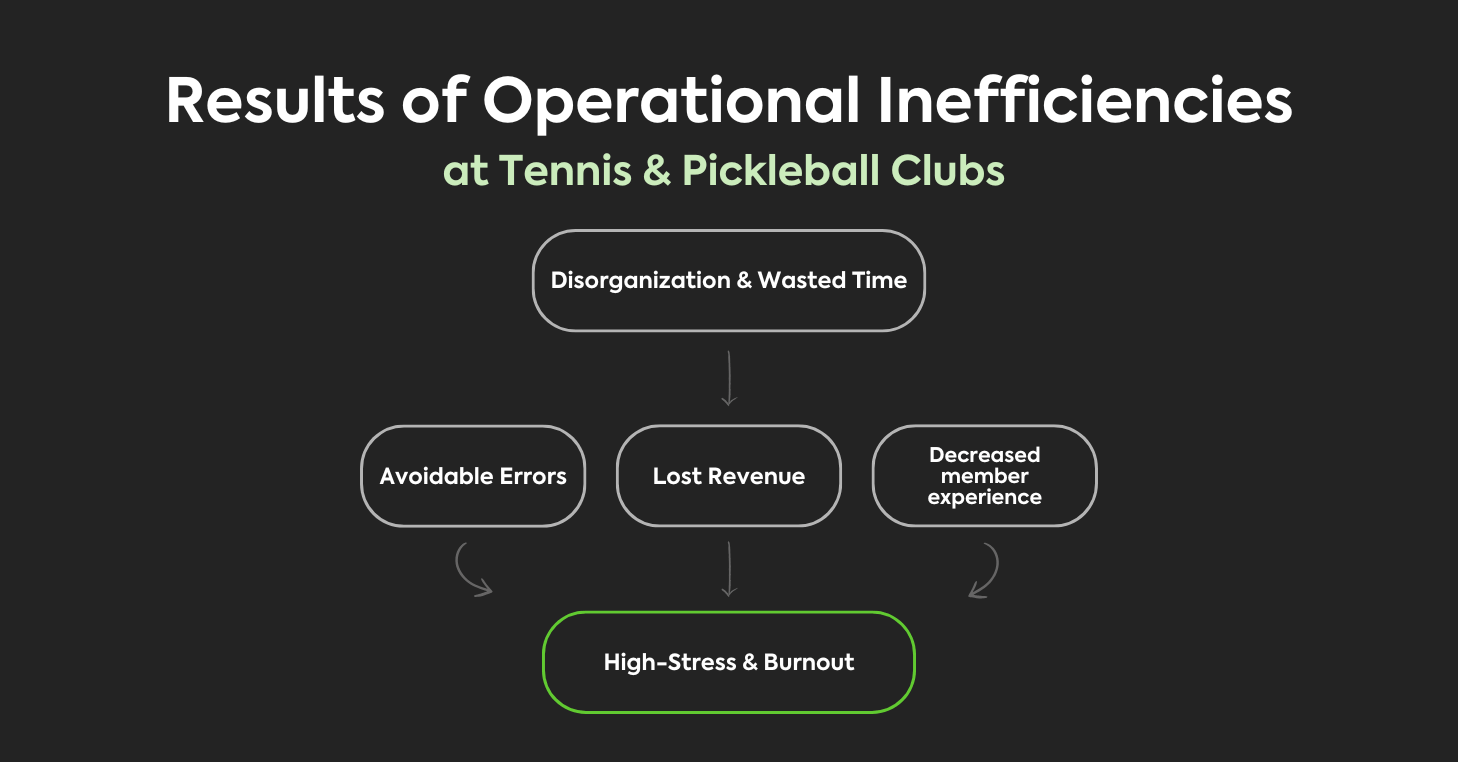
As you can see, operational inefficiencies like these often lead to the same negative outcomes. And when daily operations feel disorganized, it’s easy to get stuck in a cycle of reactive management instead of proactive growth.
Here’s the silver lining – recognizing these inefficiencies is the first step toward change. Once you identify the biggest bottlenecks, you can start making targeted improvements to create a club that runs smoothly – without running you into the ground.
How to identify your club’s biggest bottlenecks
If you’re still unsure which operational inefficiencies you’re dealing with, ask yourself:
- Where do I spend the most time on repetitive tasks?
- What are the most common complaints or issues from members and staff?
- What part of my club’s operations feels the most frustrating, chaotic, or stressful?
- Where do I feel like I’m always playing catch-up instead of staying ahead?
Answering these questions will point you toward the inefficiencies holding your club back – giving you the clarity to make meaningful changes. From there, you can start building a more efficient, less stressful future.
How to refine tennis & pickleball operations and reduce stress
Once you’ve identified the bottlenecks in your club’s operations, the next step is taking action to fix them. The key is shifting your mindset from just getting through the day to building systems that support long-term growth and ease daily operations.
By optimizing your processes, you can cut down on repetitive tasks, reduce costly errors, and improve both staff and member experiences. A well-run club doesn’t just function more smoothly – it allows you to focus on the bigger picture without feeling overwhelmed.
With that being said, this section will provide you with specific strategies to streamline your club’s daily operations, prevent burnout, and create a more efficient, sustainable management approach.
Here are some practical ways to simplify operations and take the stress out of club management:
Implement club management software
Call us biased, but one of the most effective ways to streamline operations is by using club management software designed for tennis and pickleball facilities. And that’s because these platforms centralize reservations, programming, payments, communication, member management, reporting, and more.
So instead of using fragmented tools – or worse, handling everything manually – you can use a single, integrated platform, helping you stay organized, minimize errors, and free up valuable time.
With the right club management system, you can:
- Simplify scheduling & court reservations – Avoid double bookings, manage peak hours effectively, and allow members to book courts on their own.
- Automate membership management & payments – Set up automatic renewals, process payments effortlessly, and eliminate the hassle of chasing down dues.
- Centralize communication – Keep members informed with automated reminders, event notifications, and real-time updates through one streamlined system.
- Enhance member experience – Offer self-service booking, mobile check-ins, and an intuitive platform that gives members control over their reservations and payments.
- Gain real-time insights – Easily access in-depth reports and data on court utilization, financials, Revenue Per Player, and attendance to make informed business decisions.
- Reduce admin work & staff overload – Free up time for administrators by automating repetitive tasks like scheduling, billing, and event management.
A well-designed club management software does the heavy lifting for you, so you can focus on growing your club instead of constantly managing the small details.
Laney Bevill, Owner of The Pop(opens in new window) and pickleball instructor on TeachMe.To(opens in new window), explains, “Using a club management software, like CourtReserve, has proven to be an invaluable tool for keeping the operations of a pickleball facility organized and streamlined. The software simplifies the booking process, reduces administrative work, and improves communication with both staff and members.
With features like automated reminders, easy court scheduling, and membership tracking, CourtReserve has helped minimize mistakes and the time spent on manual tasks. As a result, the workload is more manageable, providing more time for owners and managers to focus on growing their business.“

“Using a club management software, like CourtReserve, has proven to be an invaluable tool for keeping the operations of a pickleball facility organized and streamlined. ”
– Laney Bevill, Owner, The Pop
Check out our ultimate buyer’s guide if you need help choosing a solution.
Delegate and empower staff
Trying to handle everything yourself will fast-track burnout. So, you need to build a capable team that can confidently manage daily operations. When staff members are empowered with clear roles, proper training, and the right tools, they can take on more responsibility – freeing you up to focus on higher-level strategy and long-term growth.
Here’s how to delegate effectively and create self-sufficient teams:
- Identify tasks to delegate – Look at your daily workload and pinpoint repetitive, time-consuming, or low-priority tasks that don’t require your direct involvement. If a task can be automated, streamlined, or handled by someone else without sacrificing quality, it’s a strong candidate for delegation.
- Define clear roles and responsibilities – Assign specific duties to staff members so everyone knows exactly what they’re responsible for. This reduces confusion and prevents tasks from falling solely on you.
- Invest in training and development – Provide ongoing education on club operations, customer service, and technology to ensure staff can handle tasks independently.
- Trust your team and step back – Empower employees to make decisions within their roles, giving them the confidence to solve problems without constantly needing your input.
- Consider outsourcing – Hiring part-time or freelance help for court maintenance, social media, or administrative tasks can free up your time for bigger priorities. If your budget is tight, create volunteer committees for event planning or marketing to distribute the workload.
A strong, capable team is the foundation of a well-run club. When staff have clear responsibilities, the right training, and the autonomy to make decisions, daily operations become more efficient, less stressful, and easier to manage.
Delegating effectively doesn’t mean losing control – it means creating a system where your club can run smoothly without everything depending on you.
Automate repetitive tasks
One of the biggest energy and time-drainers for club owners and managers is handling the same administrative tasks over and over again. To make matters worse, these repetitive processes not only consume valuable hours, but also increase the risk of errors, miscommunication, and operational slowdowns.
By automating key tasks, you can reduce manual work, improve efficiency, and create a more seamless experience for both staff and members.
Here are some ways you can incorporate automation into your operations:
- Self-service options – Allow members to book courts, make payments, and even enter your facility via remote access technology – all without staff involvement.
- Automated payment processing – Set up recurring billing, membership renewals, and payment reminders to ensure timely payments without extra effort from staff.
- Instant event & lesson notifications – Automatically send confirmations, reminders, and updates to members to reduce no-shows and last-minute cancellations.
- Streamlined attendance tracking – Use check-in systems or digital attendance logs to track participation effortlessly.
- Easier staff management – Assign shifts, manage schedules, send reminders, track payroll, monitor performance, and more without the back-and-forth of manual coordination.
When you replace repetitive administrative tasks with automation, you free up time to focus on more important tasks that deserve your attention like growing your club and improving member engagement.
But, how do you go about automating tasks?
While a club management system is the most comprehensive and centralized way to automate operations, there are many automation tools available on the market to help you reduce manual work and increase efficiency.
Case Study: 500+ Admin Hours Saved by Automating Tasks

Founded in 1922, Balboa Tennis Club’s instructional programs, now run by HJK Ventures, needed a modern solution. After testing other providers, they chose CourtReserve for its time-saving features, automation capabilities, and customizable options tailored to their needs.
Elevate member communication
One of the most time-consuming tasks owners, managers, and staff face is the constant communication with members, guests, and prospective players. Without a structured system, messages get lost, response times slow down, and member frustration builds.
That’s why it’s important to establish clear and efficient communication. With the right strategies in place, you can improve response times and ensure a more organized experience for you, your staff, and members.
Here are a few strategies to help you simplify communication at your club:
- Provide clear points of contact – Direct specific inquiries (ex: lesson scheduling, memberships, billing) to the right person to reduce miscommunication.
- Define response times – Set expectations for when staff will respond to messages so there’s no pressure to be available 24/7.
- Set boundaries – Post official club hours for phone calls and in-person visits.
- Automate updates & reminders – Schedule event confirmations, payment notifications, and club announcements to reduce last-minute questions.
- Deliver consistent club updates – Send weekly or monthly updates (via newsletter, email blast, etc.) to highlight upcoming events, policy changes, new services, and so on.
- Set up auto-replies or a FAQs page for common questions – Use email auto-responses, chatbots, or FAQ sections to quickly address frequent questions without staff intervention.
Simplifying how you communicate by implementing a few key strategies ensures players get the information they need in an organized and efficient way – without overwhelming you or your team.
Embrace a growth framework
With constant demands, endless to-do lists, and the pressure to keep everything running smoothly, it’s easy to feel like you’re stuck in a cycle of reacting to problems instead of making real progress. When you’re constantly putting out fires, there’s little time to focus on growth, strategy, or even just catching your breath.
But what if you had a framework that helped you streamline operations and build a club that practically runs itself?
That’s exactly what the flywheel framework is designed to do. Originally introduced by business strategist Jim Collins, the flywheel represents a powerful, heavy wheel that takes effort to move at first. But once it builds momentum, it becomes nearly unstoppable.
Instead of relying on quick fixes or feeling like you have to do everything at once, the flywheel framework allows you to focus on steady improvements in key areas that make managing your club easier over time.
We’ve adapted this concept into the “club growth flywheel,” a strategic framework designed specifically for tennis and pickleball clubs. It’s built around 5 key areas that, when optimized, work together to reduce stress and prevent burnout.
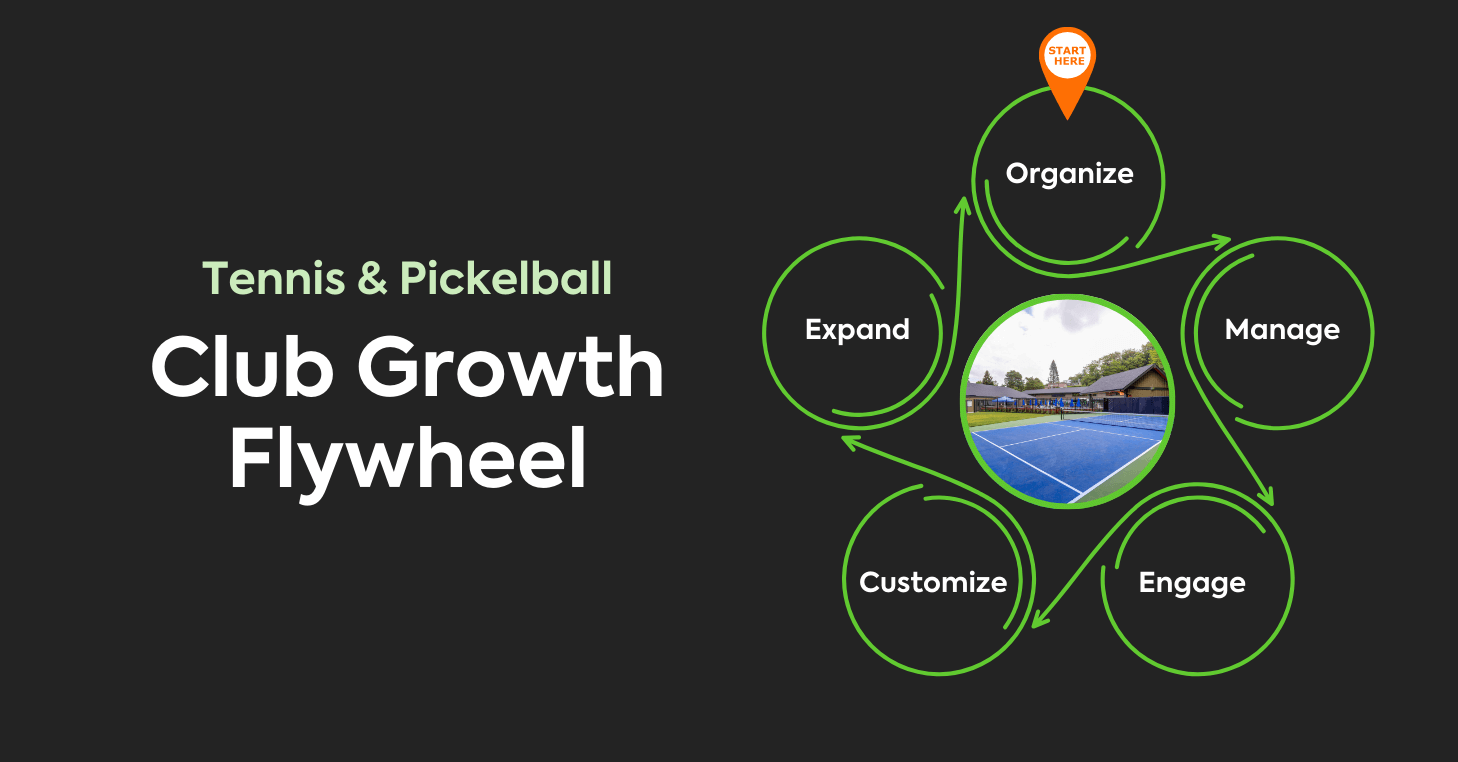
Let’s break these 5 key areas down:
- Organize – Streamline bookings, court management, and club operations so you’re not constantly troubleshooting scheduling issues.
- Engage – Foster a connected, active member base that supports retention, reducing the pressure to constantly attract new players.
- Manage – Use data-driven insights to optimize staffing, court utilization, and programming, so you’re making decisions with confidence instead of guesswork.
- Customize – Adapt your club’s offerings and technology to fit your needs, eliminating workarounds and inefficiencies that add unnecessary stress.
- Expand – Grow at a sustainable pace, adding revenue streams and locations without stretching yourself too thin.
Many club owners and managers struggle with overload simply because they don’t have the right systems in place. The club growth flywheel helps you shift from constant problem-solving to proactive, strategic management. And when your club is structured in a way that allows each improvement to build on the last, you can reduce inefficiencies, ease your workload, and shift from managing chaos to leading with confidence.
So instead of feeling like every day is an uphill battle, you’ll have a structure in place that allows your club to run more efficiently, reduce unnecessary stress, and give you the time to focus on what really matters – building a thriving club and a better experience for your members.
Establish a clear vision to avoid decision overload
Without a clear brand identity or vision for your club, it’s easy to get pulled in different directions – constantly tweaking programming, policies, or offerings to satisfy every member’s preference. Over time, this lack of focus can lead to operational chaos, overworked staff, and a club that feels disorganized instead of well-run.
Having a defined mission and strategic direction helps you set boundaries, streamline operations, and create a club experience that’s both sustainable and successful.
Michael Manglardi, Co-Founder and VP of Operations at Diadem Pickleball Complex, shares, “A common mistake that often leads to burnout is trying to be everything to everyone. While customer feedback – both positive and negative – is invaluable, operators that constantly pivot without a clear vision tend to struggle to establish a brand identity. This lack of focus can lead to decreased occupancy, inconsistent programming, and an overwhelmed staff. To overcome this, it’s important to set a clear mission and define your facility’s brand. By doing so you can set boundaries with customers and have a stronger, more concise response to member feedback.”

“A common mistake that often leads to burnout is trying to be everything to everyone. While customer feedback – both positive and negative – is invaluable, operators that constantly pivot without a clear vision tend to struggle to establish a brand identity. ”
– Michael Manglardi, VP of Ops at Diadem Pickleball Complex
Here’s how to stay focused and prevent decision fatigue:
- Define your club’s identity – Establish what makes your facility unique by defining a mission statement, core values, and so on. Use it to guide decision-making and long-term goals.
- Set realistic expectations for members – Establish clear guidelines on services, availability, and policies to avoid constant adjustments and manage member expectations.
- Stay consistent– Avoid constant changes to programming, policies, and more. Adjustments should be based on recurring feedback from multiple members, not just one-off requests. Staying consistent helps members fall into a routine and know what to expect.
- Use management tools to reinforce brand identity – Implement systems that create consistency in scheduling, communication, and operations, reinforcing your club’s identity and member experience.
By leading with a clear vision, you’ll eliminate unnecessary back-and-forth, reduce operational strain, and create a more efficient, enjoyable experience for everyone involved.
Spotlight feature: Branded Mobile App
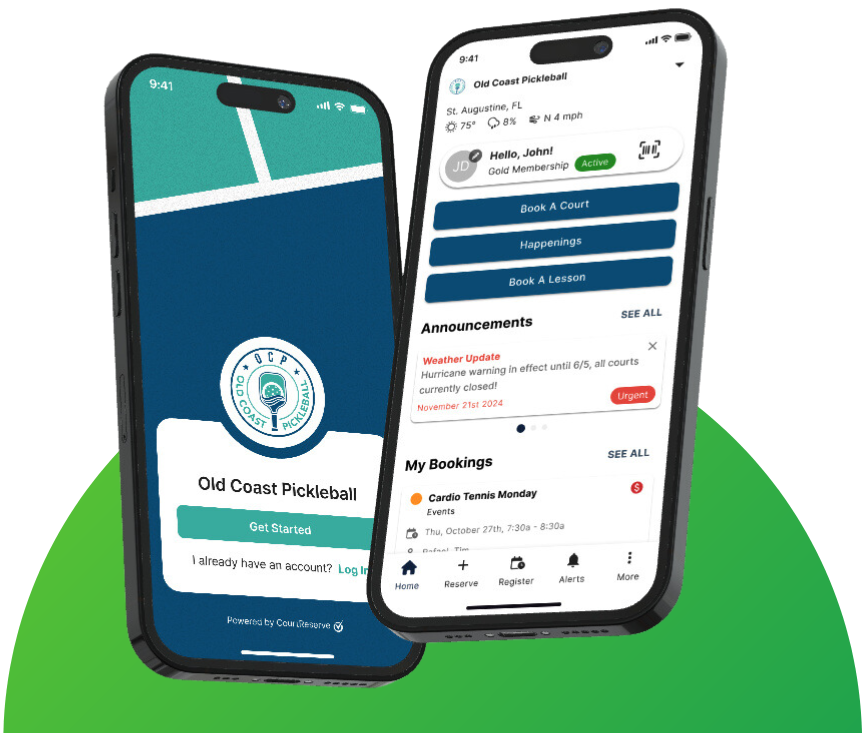
A fully customizable app for both Admins and Members, reflecting your club’s branding, powered by CourtReserve. Your branded mobile app helps streamline all aspects of your court and club management for more efficient, error-free operations. Think digital schedulers, automated payments, a member CRM, modern communications solutions, and more.
Prioritize wellbeing and self-care
Many tennis and pickleball club owners and managers feel guilty stepping away – believing that taking time for themselves means neglecting their club.
But the reality is, your club thrives when you do. If you’re burned out, overwhelmed, or running on empty, it’s nearly impossible to lead effectively, solve problems, or create a great experience for your members.
Prioritizing self-care isn’t selfish – it’s necessary for long-term success.
Here’s how to take care of yourself and your team while still managing a successful club:
- Set boundaries with work hours – Establish a clear schedule that includes time away from club operations to recharge.
- Delegate and disconnect – Trust your team to handle responsibilities so you’re not constantly on call.
- Connect with a support network – Engage with other club owners, mentors, or industry groups to share challenges, solutions, and encouragement.
- Celebrate small wins – Acknowledge progress, both personally and professionally, to stay motivated and avoid burnout.
- Schedule downtime – Block off personal time in your calendar and treat it like an important appointment. Rotate weekend or evening shifts among staff to avoid burnout from working all peak hours.
- Use stress management tools – Encourage short breaks throughout the day, even if it’s just a few minutes outside. Utilize stress-relief resources such as meditation apps or wellness programs.
Taking care of your club shouldn’t come at the expense of taking care of yourself. When you prioritize self-care, you put yourself in a stronger position to lead with clarity, problem-solve effectively, and build a club that thrives.
Run your club without running yourself into the ground
You don’t have to do everything alone. And you shouldn’t. When your club is built on strong systems and a capable team, you gain back time, energy, and the ability to lead with confidence – without burning out along the way.
A well-run club doesn’t demand more from you – it operates efficiently, allowing you to lead without constant stress. By streamlining operations, delegating effectively, and setting boundaries, you create a business that works for you, not against you.
Small, strategic changes can transform the way your club runs – reducing overwhelm, increasing productivity, and giving you the freedom to focus on what matters most.
Looking for ways to simplify and optimize your club’s operations? Explore how CourtReserve can help you simplify club management, automate tasks, and reduce daily stress – so you can focus on growing your business, not just running it.


